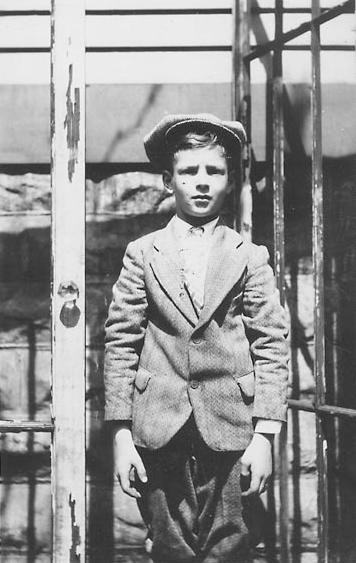
Figure 1.--This familysnapshot shows an unidentified boy wearing a tweed knickers suit with a matching or coordinated flat cap. He looks to be about 10 years old. The snapshot was dated 1930. |

|
The headwear most associated with knicker suits is the flat cap. The flat cap was not the only headwear worn with knicker suits. We see boys wearing other caps as well as hats. The flat caps was, however, by far the the most common headwear with knicker suits. The most desinctive garment worn with knicker suits was the flat cap. The two are strongly associated and are a combination most symbolic of American boyhood. In fact the period of popularity for both garments were almost identical. We see flat caps in the 1900s, but they were only one of several styles of caps worn. At the end of the decade both knicker suits and flat caps suddently increased in popularity. As a result, by the 1910s, flat caps were the standard headwear for school age American boys. We do see some diversity in the 1919s, but less in the 20s. Both were symbolic of the second and third decade of the 20th century (1910s-20s). We also see flat caps and knicker suits in the the 1930s, but they were not nearlt as common as the 1920s, especilly after the early-30s. Not only do we see more styles of headwear, but we see fewer boys wearing headwear. By the 1940s we no longer see flat caps to any extent and knickers raidly fell out of popularity in the early-40s. Some of these flat caps were made to match the suit, but most were purchased separetly. Some mothers probably picked one out to match the boy's suit rather than coming with the suit.
The headwear most associated with knicker suits is the flat cap. The flat cap was not the only headwear worn with knicker suits. We see boys wearing other caps as well as hats. Some younger boys wore other caps such as peaked caps, meaning the Cub style cap or British school cap. The flat cap was also a peaked cap, but the peak was less dominany as it was some time covered over by the rest of the cap. Some even had a snap closye to conect the cap material to the peak. It was by far the most the most common headwear American boys wore with knicker suits. It was the most desinctive garment worn with knicker suits. The two are strongly associated and are a combination most symbolic of American boyhood in the early-20th century. In fact the period of popularity for both garments were almost identical (1910s-30s). It is almpst as if they were connected. We see different styles of flat caps, the primary difference was how flat they. Many kind of pillowed up rather than being flat on top. Some seep a liitle larage for the boy's head.
It was also worn in other countries, but now here else was it so commonly worn and popular as in America. Wesee them being worn in the soviet Unioin where it had a work image, biy it was not associated with suits. We do not know why the style became so popular.
The flat cap was not entirely a boys' cap, but the flat cap was much more widely worn by boys than adults.`
The age trends varied over time. e see teenagers, even oldr teenahers wearing flat caps and knicker suits in thr 1910s, but by the 30s we mostly see grade school boys wearing them. Other caps such as the peaked caps were exclusively a boy's cap.
American boys mostly wore knee pants in the late-19th century. Knickers were not unknown, but were mich less common than knee pants. Only in the 1910s did knickers emerge as the dominant type of pants for boys. And precisely the same time, the flat cap shifted from being one of many headear styles for boys to the dominant styles and the exclusve headwear worn by many boys, especially schoolage boys. We see flat caps in the 1900s, but they were only one of several styles of caps worn. At the end of the decade both knicker suits and flat caps suddenly increased in popularity. As a result, by the 1910s, flat caps were the standard headwear for school age American boys. he flat cap was the dominant style all though the period that knickers were commonly worn (1910s-30s). It was almost as if the two were tied to the hip.
We do see some diversity in the 1910s, but less in the 20s. Both were symbolic of the second and third decade of the 20th century (1910s-20s). As knickers declined in popularity during the 1930s, so did the flat cap.
We also see flat caps and knicker suits in the the 1930s, but they were not nearly as common as the 1920s, especilly after the early-30s. Not only do we see more styles of headwear, but we see fewer boys wearing headwear.
The flat caps did not disappear after the 30s, but it became much less common and was no longer associated with suits. By the 1940s we no longer see flat caps to any extent and knickers raidly fell out of popularity in the early-40s.
Some of these flat caps were made to match the suit, but most were purchased separetly. Some mothers probably picked one out to match the boy's suit rather than coming with the suit. Some of these flat caps actually matched the suits, made in the same color and fabric. Most were bought separaetly.
Navigate the Boys' Historical Clothing Web Site:
[Return to the Main U.S. knickers suit accompanying clothing page]
[Return to the Main U.S. knickers suit page]
[Return to the Main U.S. suit pants page]
[Introduction]
[Activities]
[Biographies]
[Chronology]
[Clothing styles]
[Countries]
[Bibliographies]
[Contributions]
[FAQs]
[Glossary]
[Images]
[Links]
[Registration]
[Tools]
[Boys' Clothing Home]
